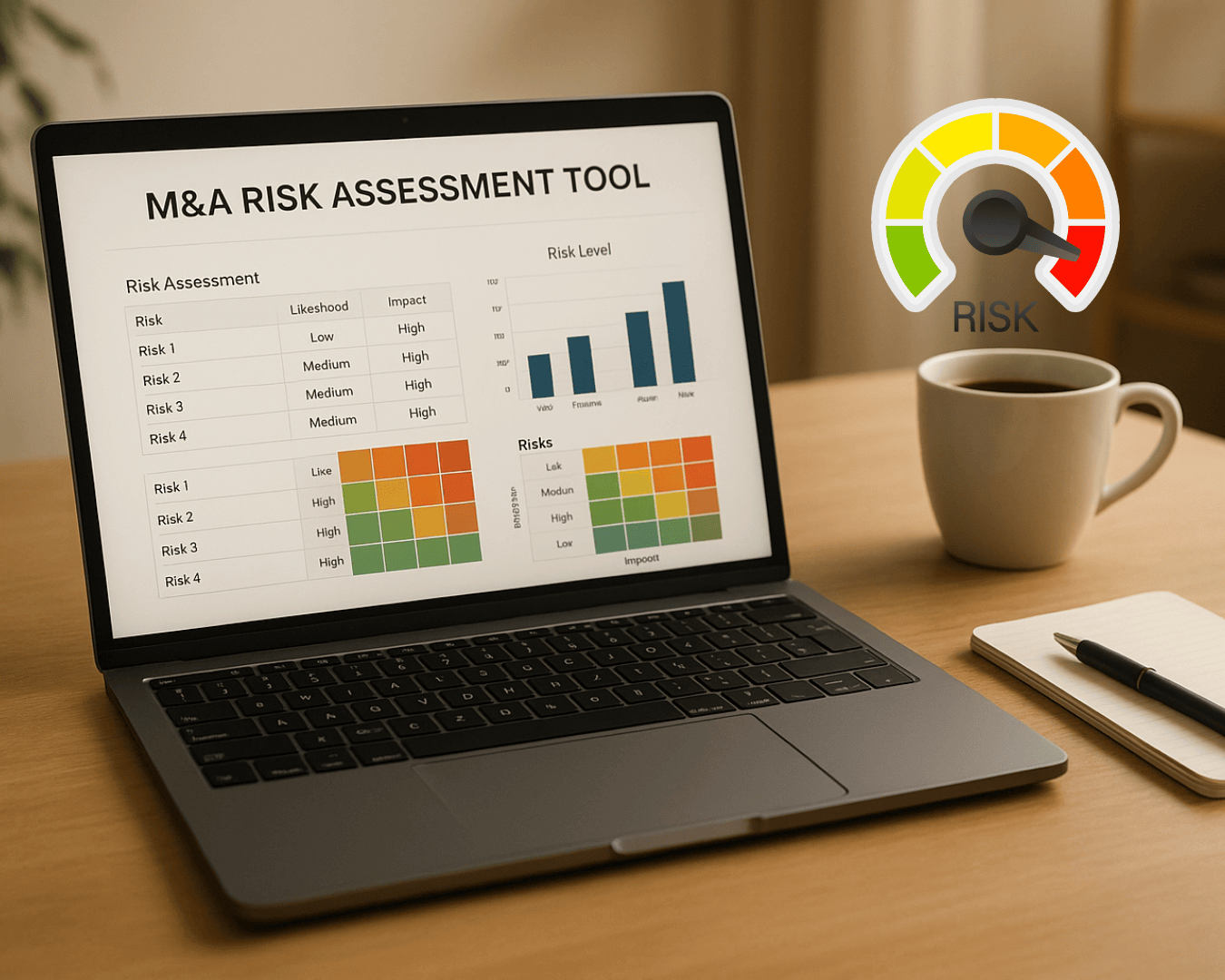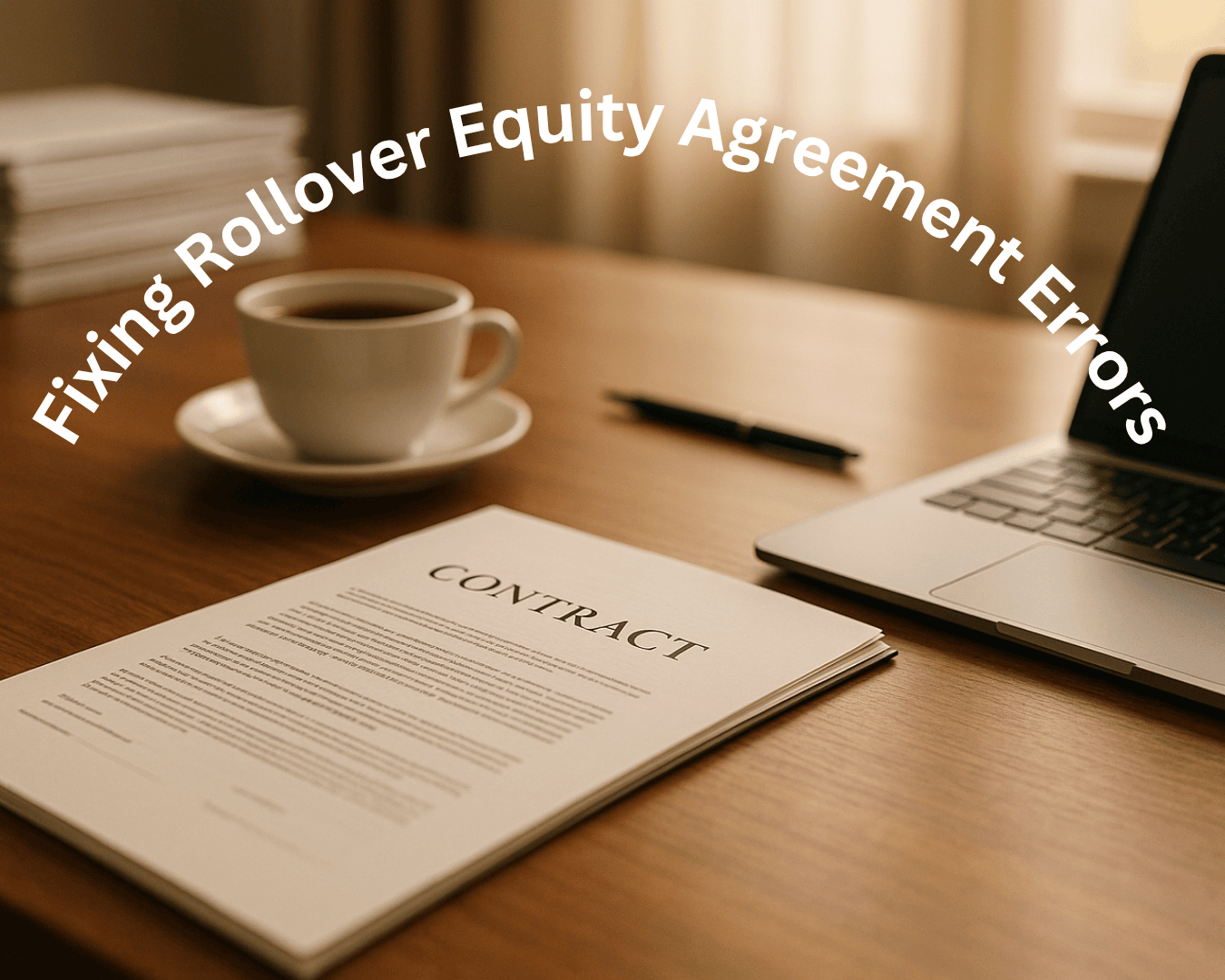Buying a business can be risky, but spotting red flags early can save you from financial losses and legal headaches. From falling revenue to legal troubles, these warning signs often indicate deeper problems that could jeopardize your investment. Here are the top 10 red flags to watch for:
- Declining Revenue or Shrinking Profit Margins: Consistent drops in sales or profits may signal poor management, market challenges, or rising costs.
- Poor or Missing Financial Records: Incomplete or disorganized records make it hard to assess a business’s true value and could hide legal or tax issues.
- Over-Reliance on a Single Customer, Supplier, or Employee: Heavy dependence on one party creates vulnerabilities if that relationship changes.
- Active Lawsuits or Compliance Issues: Legal disputes and regulatory violations can lead to costly settlements or operational disruptions.
- Outdated Equipment or Technology: Aging assets may require expensive upgrades and can slow down operations.
- Unusual Cash Transactions or Hidden Expenses: Discrepancies in cash flow or unreported costs could point to financial mismanagement or fraud.
- Seller Refuses to Sign a Non-Compete Agreement: This increases the risk of the seller starting a competing business and drawing away customers.
- High Staff Turnover or Poor Employee Relations: Frequent resignations often indicate toxic work environments or structural problems.
- Inflated Inventory or Asset Values: Overstated assets can mislead buyers about the business's worth and lead to unexpected costs.
- Growing Overdue Customer Payments: Rising unpaid invoices can signal cash flow issues or weak customer relationships.
Key takeaway: Each of these red flags can lead to costly surprises. Thorough due diligence, including financial audits and legal reviews, is essential before purchasing any business. If red flags arise, negotiate better terms or walk away from the deal.
These Are Major Red Flags When Buying a Business
1. Falling Revenue or Profit Margins
When a business starts showing declining revenue or shrinking profit margins, it’s a warning sign that can’t be ignored. These trends may point to underlying problems that could put your investment at risk.
Financial Transparency and Stability
A consistent drop in revenue over multiple periods usually signals more than just a temporary setback - it could indicate fundamental issues with the business model. It’s essential to dig deeper when faced with this kind of trend.
If revenue appears stable but profit margins are shrinking, it might mean rising costs, tougher competition, or pricing pressures are at play. These challenges could become even more pronounced after you take over the business.
Be cautious of vague reassurances from the seller, such as "it's just a rough patch." Unless these claims are supported by solid data, clear explanations, and a well-thought-out recovery plan, they should raise concerns.
Market and Growth Potential
Beyond the financial metrics, external factors can significantly influence a business's trajectory. For instance, industry-wide challenges might impact even well-run companies. However, if competitors are thriving while the business you’re evaluating is losing market share, the problem likely lies within the company itself - potentially due to poor management or inefficiencies.
Changes in customer behavior can also trigger revenue declines. Take a retail business, for example. If it’s suffering from reduced foot traffic because of shifting shopping habits, it may continue to struggle even under new ownership. Determining whether these declines are temporary or part of a permanent trend is critical to assessing the business's potential for recovery.
Seasonal businesses, in particular, require careful evaluation. A single bad season might not be alarming, but consistent downturns year after year could point to deeper, systemic issues. Looking at multi-year trends instead of just isolated periods can give you a clearer picture of the business's long-term health.
While some problems - like weak marketing, outdated inventory, or poor customer service - can often be fixed with better management, businesses facing irreversible challenges, such as permanent market shifts or an inability to compete effectively, may not be worth the risk.
2. Poor or Missing Financial Records
When considering a business acquisition, incomplete or messy financial records are a big red flag. Accurate financial records are essential for understanding a company's value and overall health. Without them, making an informed decision becomes nearly impossible.
Financial Transparency and Stability
A well-run business keeps thorough records of its income, expenses, cash flow, and balance sheets. If these financial documents are missing, incomplete, or riddled with gaps, it could point to poor management or even attempts to hide problems.
Inconsistent bookkeeping is often a sign of deeper issues. For instance, if one month has detailed expense reports but another only lists vague entries like "miscellaneous costs", it becomes tough to track where the money is going. This inconsistency can hide risks such as unreported income or personal expenditures that are being passed off as business expenses.
Even for businesses that rely heavily on cash transactions, the absence of proper documentation is a serious concern. Without accurate records of cash flow, it’s nearly impossible to confirm income levels or ensure compliance with tax regulations. These gaps don’t just cloud operational insights - they can also lead to legal troubles.
Legal and Compliance Concerns
When a seller’s financial records don’t match their tax filings, it raises serious doubts about the business’s financial integrity. Such discrepancies can also result in legal complications.
Missing documentation for significant transactions, loans, or asset purchases adds another layer of risk. These gaps can create challenges during tax audits or when trying to secure financing, as lenders typically require detailed financial records.
Payroll and employment records are another critical area. If these are incomplete, it can lead to violations of labor laws. Poor tracking of employee wages, benefits, or tax withholdings might result in penalties from state or federal agencies, creating additional liabilities for a potential buyer.
Operational Risks and Dependencies
Inaccurate inventory records can distort the true value of a business’s assets. Without proper tracking of inventory purchases, sales, and stock levels, the reported inventory value might be overstated, leading to a misleading valuation.
Similarly, incomplete accounts receivable records can hide collection problems. Without detailed aging reports or collection histories, it’s hard to gauge the business’s actual cash flow potential, which could lead to unpleasant surprises later.
Disorganized vendor and supplier records are another issue. Missing details about suppliers can cause disruptions in the supply chain after the acquisition, leaving the new owner to deal with unexpected operational headaches or liabilities.
Poor financial documentation doesn’t just complicate the due diligence process - it can also create long-term risks for anyone stepping into ownership.
3. Over-Reliance on One Customer, Supplier, or Employee
When a business leans too heavily on a single customer, supplier, or key employee, it creates a risky imbalance that potential buyers need to evaluate carefully.
Financial Transparency and Stability
Relying on one major customer can wreak havoc on cash flow if that customer decides to leave. Relationships built primarily around the business owner are especially fragile, as they rarely transfer seamlessly to a new owner. This could result in the loss of critical revenue streams.
The same holds true for dependence on a single key employee. If one person is responsible for driving sales, maintaining vital customer relationships, or managing specialized technical knowledge, their departure could cause immediate financial strain. Buyers should also examine operational dependencies to understand how reliance on specific suppliers or employees could amplify these risks.
Operational Risks and Dependencies
Relying on a single supplier, particularly when personal relationships are involved, can be a ticking time bomb. Changes in contract terms, supply chain disruptions, price hikes, or quality issues can escalate into operational chaos.
Similarly, placing too much responsibility on one key employee creates operational vulnerabilities. If that individual leaves, their absence can lead to bottlenecks, interrupt daily workflows, and expose underlying concerns like inadequate compensation, poor management practices, or subpar working conditions - issues that may persist long after a sale. Beyond these immediate concerns, such dependencies can also stifle growth, as outlined below.
Market and Growth Potential
Customer concentration can limit a business’s ability to grow. It reduces negotiating power, restricts pricing flexibility, and makes market expansion more challenging.
The same applies to supplier dependency. If the business relies on a single supplier’s capacity, product range, or geographic reach, scaling operations or entering new markets becomes a major hurdle. Additionally, when institutional knowledge is concentrated in the hands of a few key employees, rolling out new systems or exploring additional revenue streams becomes far more difficult, hampering long-term growth prospects.
Savvy buyers should assess these concentration risks thoroughly and adjust the purchase price to reflect the potential loss of value if key relationships or resources are disrupted. This careful evaluation is crucial for making a well-informed acquisition decision.
4. Active Lawsuits or Compliance Problems
When revenue dips and records are incomplete, it’s often a sign of deeper troubles. Similarly, ongoing lawsuits or compliance issues can seriously threaten a business’s stability. For buyers, these legal challenges come with significant financial risks and liabilities that may linger long after the deal is done.
Legal and Compliance Concerns
Active lawsuits are more than just a headache - they’re a major financial drain. Whether it’s employment disputes, contract breaches, or other claims, these cases can lead to hefty settlements or court judgments. And because legal battles often stretch out over months or years, the final costs can remain uncertain, making it harder to predict the true financial impact.
Regulatory compliance issues are another red flag. Businesses that lack proper licenses, violate environmental rules, or fail to meet industry standards face serious penalties. Regulatory agencies like OSHA, the EPA, or state-level authorities can impose fines, force business shutdowns, or demand costly fixes.
Tax problems with the IRS or state tax authorities add another layer of risk. Unpaid payroll taxes, sales tax violations, or disputed income tax assessments can result in liens, asset seizures, or even personal liability for business officers. These issues don’t just drain resources - they demand immediate attention and can disrupt cash flow and operations.
Financial Transparency and Stability
Legal fees can quickly spiral out of control, especially in complex cases. If a business lacks sufficient liability insurance or faces policy exclusions, the financial burden grows even heavier. For instance, professional liability, product liability, or employment practices liability insurance might not cover all claims, leaving buyers to shoulder uncovered damages.
These financial strains don’t just hit the bottom line - they can disrupt day-to-day operations, too.
Operational Risks and Dependencies
Legal challenges often pull management’s focus away from core operations. Rising legal fees and regulatory investigations can freeze business activities, limit expansion, and create uncertainty that ripples through the organization. This can make it harder to secure new contracts, renew licenses, or pursue growth opportunities.
Public legal disputes can also take a toll on a company’s reputation. Damaged relationships with customers, suppliers, or employees can lead to a loss of trust, further complicating recovery efforts.
Market and Growth Potential
Legal troubles can severely limit a company’s ability to grow. Court-imposed restrictions or contractual obligations might block access to certain customers, geographic markets, or business activities. Additionally, lenders may grow wary, tightening credit terms or raising interest rates, which can restrict access to much-needed capital for investments like equipment upgrades or working capital.
In some cases, businesses may face industry exclusions - such as being barred from government contracts, losing professional certifications, or getting removed from industry associations. These setbacks can shrink revenue streams and weaken competitive positioning.
To navigate these challenges, buyers should insist on full legal disclosures. This includes a detailed account of all ongoing lawsuits, regulatory investigations, and compliance issues. Negotiating indemnification clauses and setting up escrow arrangements in the purchase agreement can provide added protection against unexpected legal liabilities after the deal closes.
5. Old Equipment or Technology Needing Major Updates
Outdated equipment, much like declining revenues or legal troubles, can be a warning sign of deeper issues within a business. Aging machinery or obsolete technology can turn what seems like a great acquisition into an expensive burden. These assets often require substantial investment to replace and can disrupt operations in the process.
Financial Transparency and Stability
Replacing outdated equipment can come with hefty price tags. Some businesses may need entirely new production lines or significant IT system upgrades to stay functional.
Older equipment also tends to bring hidden costs. Maintenance expenses climb as machines age, and inefficiencies - like higher energy consumption, increased waste, or extra labor requirements - can quietly eat away at profit margins.
Operational Risks and Dependencies
Machinery nearing the end of its lifespan introduces significant risks. Breakdowns can lead to production delays, quality issues, and even unexpected shutdowns, all of which can damage customer relationships and disrupt supply chains.
Technology dependencies add another layer of complexity. Legacy systems often struggle to integrate with newer tools, making it harder for a company to modernize or streamline operations. Additionally, when manufacturers stop supporting older models, finding replacement parts can become a challenge. This forces companies to rely on third-party providers, leading to longer downtimes and unpredictable repair costs.
These operational hurdles can directly affect a business's valuation and its ability to sustain long-term success.
Legal and Compliance Concerns
Outdated equipment may fail to meet current safety, environmental, or quality regulations, exposing the business to compliance risks. This can lead to fines, legal challenges, or even forced operational changes.
Market and Growth Potential
Old technology can act as a roadblock to growth. Companies using outdated systems often struggle to compete on speed, quality, or cost efficiency. This disadvantage can make it difficult to keep up with competitors and meet the evolving expectations of customers.
Businesses relying on obsolete systems may also find that growth requires a complete technology overhaul rather than incremental upgrades. This adds both cost and complexity to expansion plans, making it essential to evaluate whether the business can remain competitive after acquisition.
Before moving forward with any deal, conduct a detailed review of the equipment and technology in place. Include potential replacement or upgrade costs in your valuation and negotiate price adjustments for any deficiencies you uncover. Also, consider whether the business can maintain operations during a transitional period and whether you have the resources and expertise to handle the necessary updates.
sbb-itb-a3ef7c1
6. Strange Cash Transactions or Hidden Expenses
Unusual cash handling or hidden expenses can be a major red flag for potential buyers. When sellers struggle to explain cash flows or fail to disclose certain costs, it could point to sloppy financial management - or worse, intentional deception.
Financial Transparency and Stability
Cash transactions that don't line up with a business's operations can seriously undermine its financial credibility. For example, businesses that deal with large amounts of unreported cash, maintain secret bank accounts, or show discrepancies between reported sales and bank deposits raise serious questions about their true financial health.
Hidden expenses are another concern. Whether it's unreported maintenance costs, off-the-books contractor payments, or personal expenses disguised as business costs, these practices can distort profitability. For instance, frequent large cash withdrawals without corresponding business expenses - or cash deposits that don’t match reported sales - could signal either poor record-keeping or deliberate manipulation. Both scenarios pose risks for buyers who rely on accurate financial data to make informed decisions. This lack of transparency not only skews the business's earnings but could also lead to legal headaches down the road.
Legal and Compliance Concerns
Strange cash transactions often come with tax compliance issues that can haunt new owners long after the sale. If a business underreports cash income to dodge taxes, the IRS could impose penalties that transfer to the buyer. This could mean audits, fines, and back-tax liabilities - none of which any new owner wants to inherit.
In some cases, unreported cash transactions might also violate banking regulations. Businesses in certain industries are required to report significant cash transactions to federal authorities. Ignoring these rules could result in steep fines and regulatory scrutiny.
Another risk involves employment law violations. Businesses that pay employees in cash without proper tax withholdings or workers' compensation coverage could leave buyers exposed to lawsuits or regulatory penalties. These hidden employment costs can quickly add up, creating unexpected financial burdens after the acquisition.
Operational Risks and Dependencies
Cash-heavy businesses often lack the financial controls and documentation needed for smooth operations. Without proper tracking systems, it’s difficult for new owners to analyze customer behavior, seasonal trends, or operational efficiency. This lack of data makes it nearly impossible to implement improvements or plan for growth.
Poor cash management can also hurt vendor relationships. Suppliers may insist on cash-on-delivery terms or upfront payments, which limits operational flexibility and creates additional working capital demands. For a new owner, this could make managing cash flow a constant challenge.
There’s also the issue of customer payment irregularities. If a business relies on unusual payment methods or has inconsistent collection practices, it could signal deeper problems with customer relationships or service quality. These issues can disrupt revenue stability and demand significant time and effort to fix.
Before buying a business with questionable cash practices, insist on reviewing all bank statements, demand clear explanations for any odd transactions, and consider hiring a forensic accountant to dig deeper into the financials. Be sure to account for potential compliance costs and operational improvements when valuing the business. Most importantly, include legal safeguards in the purchase agreement to protect against any hidden liabilities. A thorough audit during due diligence is critical to avoid unpleasant surprises.
7. Seller Refuses to Sign Non-Compete Agreement
When a seller declines to sign a non-compete agreement, it raises a red flag for potential competition. This hesitation might suggest that the seller intends to re-enter the market, creating serious challenges for the buyer.
Operational Risks and Dependencies
A seller’s refusal to stay out of the market introduces a competitive threat. Their in-depth knowledge of the business - covering operations, customer needs, supplier relationships, and employee roles - gives them a significant advantage. This risk is especially concerning in service-driven industries where personal connections are crucial to maintaining revenue. Without a non-compete agreement in place, a former owner could easily reconnect with loyal customers, potentially diverting revenue and disrupting cash flow.
Additionally, the seller could use their insider knowledge to target key staff, suppliers, or clients, further destabilizing the acquired business. These operational risks make it essential for buyers to consider strong legal protections.
Legal and Compliance Concerns
Without a non-compete agreement, buyers are exposed to the possibility of the seller using their insider knowledge to compete directly. The former owner’s established relationships, familiarity with the business model, and understanding of market trends could put the new owner at a disadvantage. If disputes arise, the lack of a contractual safeguard makes it much harder to seek damages or prevent harmful actions through legal means.
Market and Growth Potential
The seller's refusal to sign a non-compete may also hint at broader concerns about the business's future. For instance, they might foresee market disruptions, new competitors, or regulatory changes that could affect profitability. As one industry expert explains:
"If a seller is unwilling to sign a reasonable non-compete agreement, consider why: Do they plan to open a competing business? Are they aware of pending market disruptions? Do they have doubts about the business's sustainability?"
– DueDilio
This reluctance could indicate that the seller is keeping their options open, potentially undermining the buyer's ability to grow the business. Competing against someone with detailed operational insights can make it significantly harder for new owners to expand their market share or implement growth strategies.
Before proceeding with an acquisition where the seller resists signing a non-compete, it’s crucial to dig deeper. Investigate whether the seller has a pattern of building and selling businesses in the same industry. Additionally, assess the strength of customer relationships and how easily they could shift to a competing venture. These steps can help buyers better understand the risks and make informed decisions.
8. High Staff Turnover or Poor Employee Relations
When employees frequently leave a business, it often points to deeper, underlying issues. High staff turnover can reveal significant problems with management or workplace culture - issues that don’t always show up in financial reports. These challenges can directly affect how smoothly the business operates and its overall stability.
Operational Risks and Dependencies
High turnover often stems from poor leadership or a toxic work environment. When experienced employees leave, they take with them critical knowledge about the business - whether it’s key operational processes, customer relationships, or insights into day-to-day functions. Replacing this expertise takes time and money, which can disrupt service quality in the interim.
The problem compounds when turnover becomes a persistent issue. Businesses may be forced to operate with minimal staff to save costs, leaving the remaining employees overwhelmed and stressed. This creates a vicious cycle: overworked employees are more likely to leave, further destabilizing the workforce.
Losing key personnel with specialized skills or strong customer relationships can have immediate consequences, including reduced revenue and operational setbacks. These departures are especially costly because they often disrupt core business functions.
Legal and Compliance Concerns
High turnover doesn’t just hurt operations - it can also lead to legal headaches. For buyers, there’s a risk of inheriting unresolved employee disputes, such as claims of harassment, bullying, unfair dismissal, or unpaid wages. Even if these problems occurred under previous ownership, new owners could still face lawsuits or settlement costs.
Workplace conflicts, such as harassment or bullying, might not be obvious during due diligence, but these issues can result in expensive legal battles, regulatory scrutiny, and damage to the company’s reputation. Additionally, businesses with high turnover may be masking employment law violations, such as non-compliance with labor laws, wage standards, or workplace safety regulations. These violations can lead to penalties, fines, and further legal expenses.
Market and Growth Potential
Just like financial irregularities, high turnover can highlight deeper operational weaknesses that might hinder growth. Employees often notice problems - like customer dissatisfaction or operational inefficiencies - before these issues are reflected in financial data. High turnover could be a sign that staff are leaving because they see these red flags.
When experienced employees leave, service quality often suffers, leading to inconsistent customer experiences and strained relationships. This can directly limit a company’s ability to grow and compete in the market.
Additionally, low morale and engagement among remaining employees can drag down productivity and customer service. If a company lacks opportunities for employee advancement or growth, it’s more likely to lose top talent, further signaling structural problems that make it hard to retain skilled workers.
Before acquiring a business with high turnover, it’s crucial to dig into the root causes. Reviewing employee records, conducting exit interviews (when possible), and evaluating whether the workplace culture and management practices can realistically improve under new ownership are all vital steps to reduce these risks.
9. Inflated Inventory or Asset Values
Accurate valuation is a cornerstone of protecting your investment during an acquisition. When asset values are inflated, they can paint a misleading picture of a business's worth, making it essential to identify these warning signs early. This ties closely to financial transparency, as overvalued assets can distort the true financial health of a company.
Financial Transparency and Stability
Overstating equipment values, inflating inventory costs, or including uncollectible receivables are common tactics that can artificially drive up the asking price. These practices not only mislead potential buyers but can also introduce hidden liabilities. For instance, unsellable inventory may require markdowns or disposal, cutting into profitability. Similarly, aging or outdated equipment might necessitate costly repairs or replacements, further impacting the bottom line.
Reviewing aging reports is another critical step. These reports can reveal overdue or at-risk accounts receivable, which may otherwise go unnoticed. Misrepresented asset values don’t just affect financial statements - they can also disrupt daily operations.
Operational Risks and Dependencies
Inaccurate valuations can lead to operational headaches. If equipment is in worse shape than claimed, it could result in production delays or service interruptions. Outdated machinery that frequently breaks down or relies on obsolete technology can throw a wrench into smooth operations.
Inventory issues are another area to watch. A stockpile of obsolete or slow-moving items ties up working capital and can hurt customer satisfaction. Buyers should also confirm asset ownership. In some cases, critical equipment or fixtures may belong to a landlord, meaning they won’t transfer with the sale.
Legal and Compliance Concerns
Miscalculated asset values can also create legal and compliance nightmares. Non-compliant equipment might require immediate upgrades or replacements, adding unexpected costs. Missing warranties or incomplete service records could leave buyers exposed to liabilities and higher insurance premiums. Intangible assets, such as intellectual property, may also carry legal risks if their ownership or documentation isn’t clearly established.
To avoid these pitfalls, thorough due diligence is a must. This includes auditing inventory, arranging independent appraisals, inspecting physical assets, and verifying maintenance and ownership records . Cross-checking asset values against current market prices and analyzing aging reports for accounts receivable are also critical steps to ensure you’re getting an accurate picture of the business’s true value.
10. Growing Overdue Customer Payments
An increase in overdue payments is often a warning sign that points to deeper systemic problems. When a business's accounts receivable pile up or its overdue payments grow, it could be a sign of trouble - ranging from strained customer relationships to operational inefficiencies that could jeopardize your investment.
Financial Transparency and Stability
A rise in aging receivables often signals financial instability. When customers delay or stop making payments, it creates a cash flow crunch that can quickly spiral out of control.
Healthy businesses generally collect receivables within 30 to 60 days. If payment terms stretch too long or bad debts consistently pile up, it’s a clue that reported revenue may not reflect reality. The situation worsens when companies continue to record revenue from customers unlikely to pay. This practice can inflate profitability on paper, and some sellers even include these shaky receivables in their asking price - essentially charging you for money they’ll never collect.
Bad debt write-offs are another red flag. If a business regularly writes off large amounts of uncollectible debt, it could point to poor credit policies, a declining customer base, or both. These write-offs eat into profitability and raise questions about the reliability of the company’s revenue streams. Over time, this financial strain often spills over into operational challenges.
Operational Risks and Dependencies
Overdue payments don’t just impact finances - they often reveal operational weaknesses. Customers may stop paying because they’re unhappy with product quality, delivery delays, or inadequate customer support.
When a key customer delays payments, the business faces immediate cash flow risks. If that customer defaults entirely, the consequences could be dire, even leading to bankruptcy. Poor collection practices and weak credit management systems often exacerbate the problem. Businesses that fail to conduct credit checks, enforce credit limits, or follow up systematically on overdue accounts are setting themselves up for trouble. If you’re considering acquiring a business, scrutinize its accounts receivable processes carefully.
The ripple effect extends to working capital. Cash tied up in overdue payments means the business may struggle to pay suppliers, maintain inventory, or fund necessary upgrades. This creates a vicious cycle: operational performance declines, customers grow more dissatisfied, and payment delays increase.
Legal and Compliance Concerns
Overdue payments can also lead to legal headaches. Chasing down unpaid invoices often results in costly legal battles, with no guarantee of recovery.
In some industries, lien and security interest issues add complexity. If a business hasn’t properly secured its interests - such as filing liens for services or materials used in larger projects - it may have little recourse if customers don’t pay. Additionally, businesses under cash flow pressure may resort to aggressive collection tactics, which can backfire by damaging customer relationships or even leading to legal liabilities.
Bankruptcy among customers is another potential pitfall. If a customer files for bankruptcy, outstanding receivables may become uncollectible. Worse, any payments received within 90 days of the bankruptcy filing may need to be returned under "preference payment" rules, turning what seemed like recovered funds into fresh losses.
Market and Growth Potential
A pattern of growing overdue payments often reflects broader market challenges or increased competition. When industries face economic downturns, businesses in those sectors may struggle to collect payments as their own customers face financial strain.
Customer quality is another concern. If a business has been forced to accept riskier customers to maintain sales, those customers are more likely to delay or default on payments. This shift suggests the business could be losing its competitive edge.
Competition also plays a role. If rivals offer better terms, superior quality, or lower prices, customers may prioritize paying those vendors first, leaving others waiting. This could indicate the business is losing market share and may face ongoing collection challenges.
Understanding payment norms within the industry is crucial. Some sectors, like construction or government contracting, naturally operate with longer payment cycles, while others expect faster turnarounds. Evaluating these norms helps determine whether delays are typical or a sign of trouble. Overdue payments don’t just strain current operations - they can also stifle future growth opportunities.
Conclusion
Buying a business is a big financial commitment, and the ten red flags we've discussed can be the difference between a smart investment and a costly mistake. Recognizing these warning signs is a crucial part of your due diligence process.
Financial transparency is key. Issues like poorly maintained records, unexplained cash transactions, or overinflated valuations can point to deeper problems that may surface after the purchase. Operational concerns - such as outdated equipment, high employee turnover, or a heavy reliance on a few key relationships - can add to these risks and quickly eat away at your investment.
Legal and compliance issues, along with market conditions, also play a major role in a business's viability. Active lawsuits, unresolved collections, or a seller unwilling to sign a non-compete agreement can expose you to hidden liabilities or future competition. For example, a seemingly small refusal to sign a non-compete could lead to the seller opening a rival business and pulling away key customers.
What makes these red flags even more challenging is how interconnected they often are. Addressing one issue can uncover others, which is why a thorough and methodical approach to due diligence is so important.
Professional advice can make all the difference. Financial advisors can help analyze complex accounting issues, business brokers bring valuable market insights, and legal experts ensure you're aware of any liabilities while structuring deals to protect your interests.
Platforms like Clearly Acquired simplify this process by offering tools like AI-driven valuations, secure document reviews, and verified deal opportunities. These resources can help you catch potential issues early and connect you with the right professionals.
Red flags aren’t always deal-breakers - they can also be opportunities to negotiate better terms or walk away from deals that don’t align with your risk tolerance. Sometimes, businesses with obvious but manageable issues can turn into great investments if priced right, while seemingly perfect businesses might hide serious challenges.
The goal isn’t to find a flawless business - it’s to choose one where you fully understand the risks, have a plan to address them, and are paying a fair price that reflects both the value and the challenges ahead. Armed with a clear understanding of these red flags and the guidance of experienced professionals, you’ll be ready to make informed decisions that protect your investment and set you up for long-term success.
FAQs
What should I do if I notice multiple warning signs while reviewing a business for sale?
If you notice multiple red flags during the due diligence process, it’s crucial to tread carefully. Start by closely examining the financial records to identify any discrepancies or irregularities. Make sure the business is fully compliant with legal and regulatory standards. Take a hard look at its operations to spot any major risks, such as an overdependence on key personnel or outdated technology.
It’s often wise to bring in experts, like accountants or attorneys, to help evaluate the seriousness of these issues. Based on your findings, you might need to renegotiate terms, request further documentation, or, in some cases, walk away entirely if the risks outweigh the potential rewards. These steps can safeguard your investment and help you steer clear of expensive missteps.
What steps can I take to negotiate better terms if I uncover red flags while evaluating a business for sale?
If you spot potential issues during your evaluation, these can be powerful tools for negotiating better terms. For instance, you might propose a lower purchase price to offset the risks or request that a larger portion of the payment be placed in escrow until specific concerns are addressed.
You could also negotiate contingencies, like linking part of the payment to the business's future performance or requiring the seller to resolve particular problems before finalizing the deal. By clearly communicating your concerns and fully understanding the challenges, you’ll be in a stronger position to negotiate effectively.
Why should a seller sign a non-compete agreement, and what risks do I face if they don’t?
A non-compete agreement is a safeguard that ensures the seller won’t launch a rival business or lure away customers after the sale is complete. This is particularly important in industries where the seller has established close client relationships or possesses specialized knowledge.
If a seller hesitates or refuses to sign such an agreement, it might signal plans to compete with you down the line, which could jeopardize your investment. Without this protection, you risk losing customers, market share, or even valuable employees to the seller’s future endeavors. Securing a well-defined and enforceable non-compete clause is essential to protecting your business and its long-term success.












.png)







































.png)








































%20Loan%20Application%20Checklist.png)
















